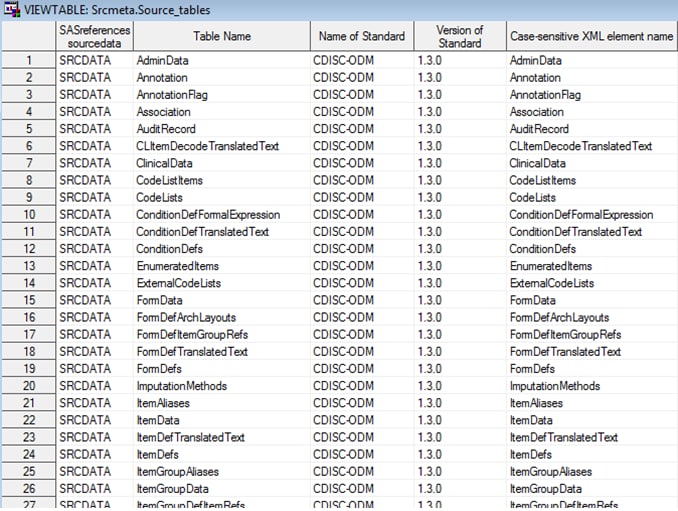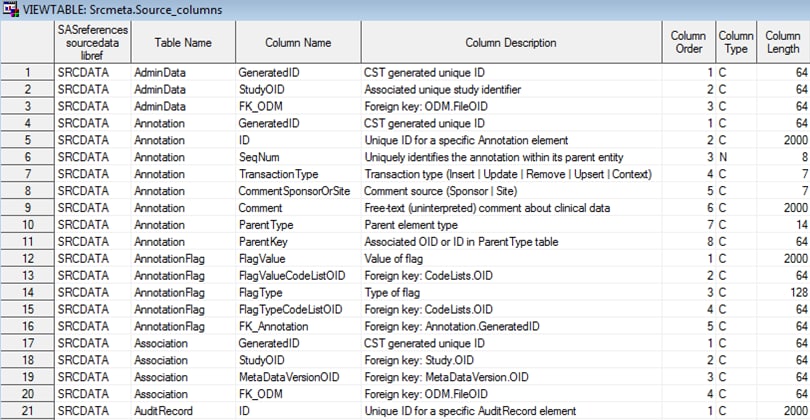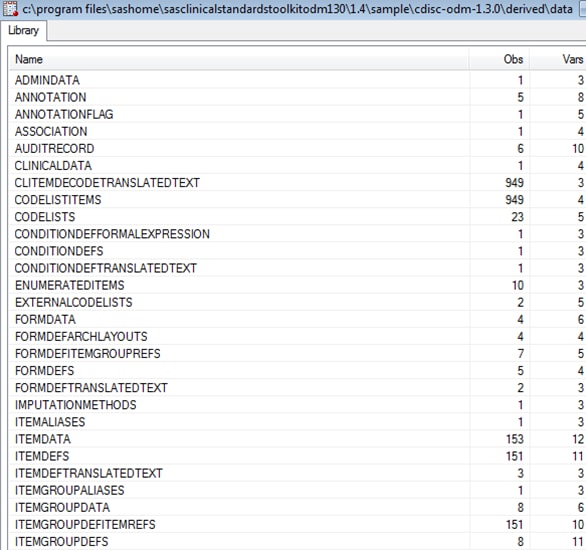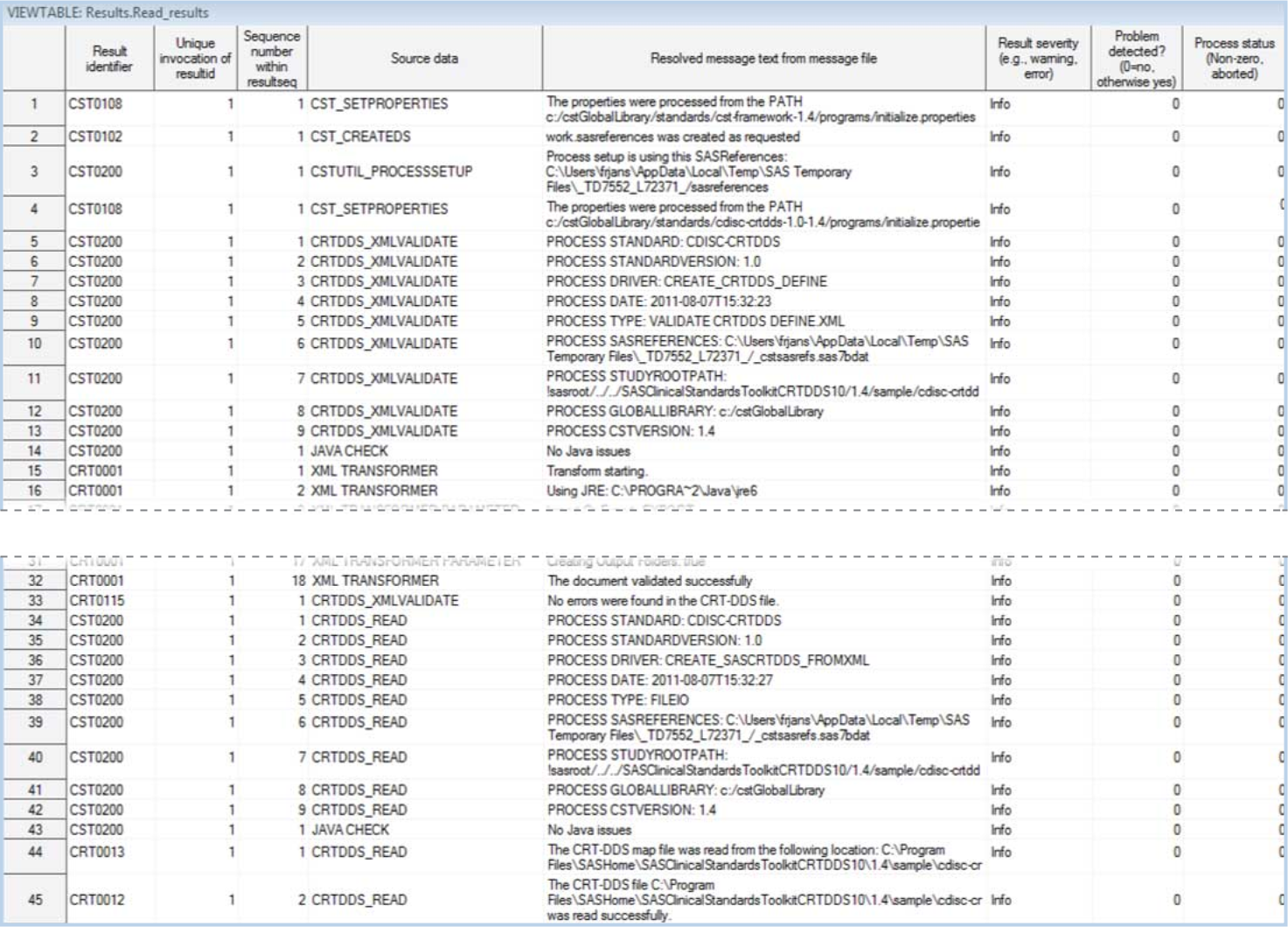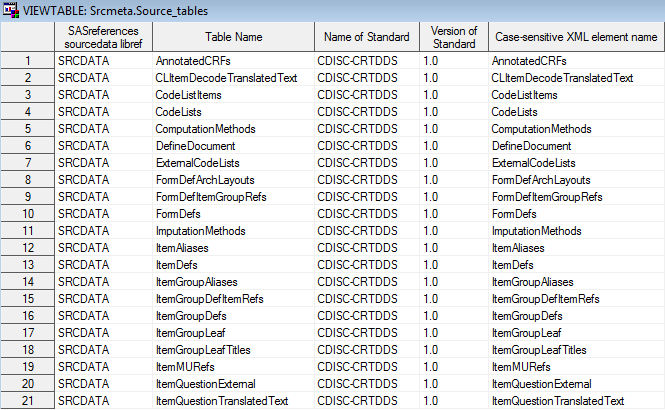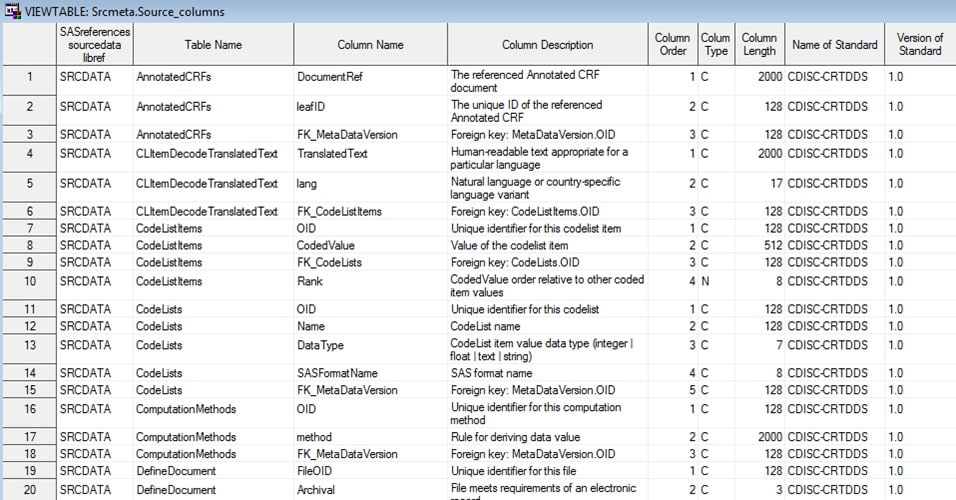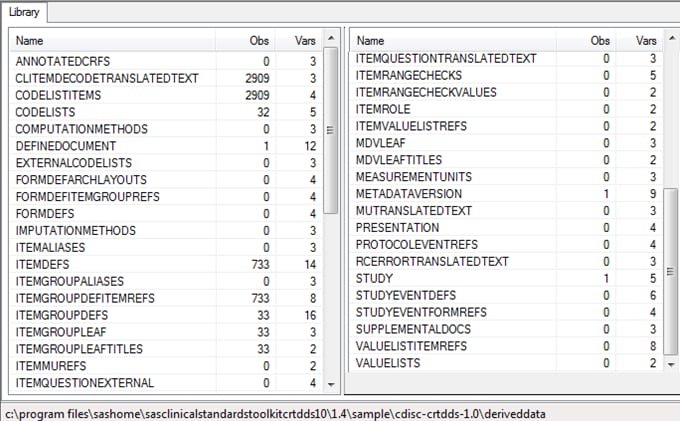Reading XML Files
Reading CDISC ODM XML Files: odm_read Macro
In order to read an
ODM XML file, a specialized macro named odm_read is available in the
ODM 1.3.0 standards macro folder. This folder is located here:
This macro is referenced
from the create_sasodm_fromxml.sas driver program (described more
fully below).
File references and
other metadata that are required by the macro are set as global macro
variable values. Currently, these global macro variable values are
set through the framework initialization properties and the CDISC
ODM 1.3.0 initialization properties. Throughout the processing of
the odm_read macro, the Results data set contains all framework and
ODM 1.3.0 specific messages generated during run time.
Based on file references
defined in the SASReferences data set, the odm_read macro accesses
the ODM XML file.
<?xml version="1.0" encoding="ISO-8859-1"?>
<ODM
xmlns="http://www.cdisc.org/ns/odm/v1.3"
FileOID="Study1234"
ODMVersion="1.3"
FileType="Snapshot"
CreationDateTime="2004-07-28T12:34:13-06:00"
SourceSystem="ss00"
AsOfDateTime="2004-07-29T12:34:13-06:00"
Granularity="SingleSite"
Description="Study to determine existence of ischemic stroke"
Archival="Yes"
PriorFileOID="Study-4321"
Originator="SAS Institute"
SourceSystemVersion="Version 0.0.0"
Id="DSSignature123">
<Study OID="1234"
<GlobalVariables>
<StudyName>1234</StudyName>
<StudyDescription>1234 Data Definition</StudyDescription>
<ProtocolName>1234</ProtocolName>
</GlobalVariables>
<MeasurementUnit OID="MeasurementUnits.OID.MMHG" Name="MMHG"
<Symbol>
<TranslatedText xml:lang="en">mmHG</TranslatedText>
<TranslatedText xml:lang="fr-CA">mmHG</TranslatedText>
</Symbol>
</MeasurementUnit>
<MeasurementUnit OID="MeasurementUnits.OID.YRS" Name="YEARS">
<Symbol>
<TranslatedText xml:lang="de">Jahren</TranslatedText>
<TranslatedText xml:lang="en">Years of age</TranslatedText>
<TranslatedText xml:lang="fr-CA">Ans</TranslatedText>
</Symbol>
</BasicDefinitions>
<MetaDataVersion MetaDataVersion OID="CDISC.SDTM.3.1.0"
Name="Study 1234, Data Definitions"
Description="Study 1234, Data Definitions">
<Include StudyOID="1234" MetaDataVersionOID="MDV000">
</Include>
<Protocol>
<Description>
After the odm_read macro
confirms that the ODM XML file exists, a call is made to the SAS DATA
step component JavaObj. JavaObj processing converts the ODM XML file
into the cubeXML file through transformations using XSL files and
processes. The cubeXML file is created in the Work library. The name
of the cubeXML file is _cubnnnn.xml, where nnnn is a
randomly generated number. The cubeXML file is accessed using the
SAS XML LIBNAME engine and XMLMAP processing. A default XMLMAP file
is stored in the sample ODM 1.3.0 study folder hierarchy under
/referencexml<?xml version="1.0" encoding="windows-1252"?>
<SXLEMAP name="ODM130" version="1.2">
<TABLE name="ItemDefs">
<TABLE-PATH syntax="XPath">/LIBRARY/ItemDefs</TABLE-PATH>
<TABLE-DESCRIPTION>Item metadata</TABLE-DESCRIPTION>
<COLUMN name="OID">
<PATH syntax="Xpath">/LIBRARY/ItemDefs/OID</PATH>
<TYPE>character</TYPE>
<DATATYPE>character</DATATYPE>
<DESCRIPTION>Unique identifier for this item</DESCRIPTION>
<LENGTH>64</LENGTH>
</COLUMN>
<COLUMN name="Name">
<PATH syntax="Xpath">/LIBRARY/ItemDefs/Name</PATH>
<TYPE>character</TYPE>
<DATATYPE>character</DATATYPE>
<DESCRIPTION>Item (variable) name</DESCRIPTION>
<LENGTH>128</LENGTH>
</COLUMN>
<COLUMN name="DataType">
<PATH syntax="Xpath">/LIBRARY/ItemDefs/DataType</PATH>
<TYPE>character</TYPE>
<DATATYPE>character</DATATYPE>
<DESCRIPTION>Item (variable) data type (text, integer, float)</DESCRIPTION>
<LENGTH>18</LENGTH>
</COLUMN>
<COLUMN name="Length">
<PATH syntax="Xpath">/LIBRARY/ItemDefs/Length</PATH>
<TYPE>numeric</TYPE>
<DATATYPE>numeric</DATATYPE>
<DESCRIPTION>Item (variable) length</DESCRIPTION>
<LENGTH>8</LENGTH>
</COLUMN>When the cubeXML is
processed, each of the 66 data sets (such as ItemDefs) that are included
in the SAS representation of the CDISC ODM model is derived.
A number of input parameters
can be specified in the call to the odm_read macro. These parameters
offer the options of building source metadata files and SAS format
catalogs for codelist translated text. These parameters are itemized
in this table.
ODM_read Macro Parameters
By default, if a null-parameter
%odm_read() macro call is made, source metadata files and SAS format
catalogs for each language found in the clitemdecodetranslatedtext
data set are created after the SAS data sets representing the ODM
XML metadata and data content are derived. The target location of
the derived metadata files is defined in the SASReferences data set.
The target location of any derived SAS format catalogs is the SAS
Work library unless defined in the SASReferences data set.
Sample Driver Program: create_sasodm_fromxml.sas
Overview
The SASReferences Data Set
As a part of
each SAS Clinical Standards Toolkit process setup, a valid SASReferences
data set is required. It references the input files that are needed,
the librefs and filenames to use, and the names and locations of data
sets to be created by the process. It can be modified to point to
study-specific files. For
an explanation of the SASReferences data set, see SASReferences File.
In the SASReferences
data set, there are two input file references and five output references
that are key to the successful completion of the driver program. Key Components of the SASReferences Data Set lists these
files and data sets, and they are discussed in separate sections. In the sample create_sasodm_fromxml.sas driver module,
these values are set for &studyRootPath and &studyOutputPath:
&studyOutputPath=!sasroot /../../SASClinicalStandardsToolkitODM130/&cstVersion/sample/cdisc-odm-1.3.0Process Inputs
The metadata type externalxml
refers to the ODM XML file that is being read. The filename reference
odmxml is defined in the SASReferences data set. This filename reference
is used in the submitted SAS code when referring to the ODM XML file.
The metadata type referencexml
refers to the SAS map file that is used to generate the SAS data sets
that represent the ODM file metadata and content. The filename reference
odmmap is defined in the SASReferences data set. This filename reference
is used in the submitted SAS code when referring to the SAS map file.
If a path and filename for the map file is not specified, then a temporary
map file is created as part of the odm_read processing.
Process Outputs
When the driver program
finishes running, the read_results data set is created in the Results
library. This data set contains informational, warning, and any error
messages that were generated by the submitted driver program.
This display shows
an example of the contents of a Results data set that was built while
reading the sample ODM XML file that was provided by SAS.
Example of a Partial Results Data Set Created by the create_sasodm_fromxml.sas
Driver
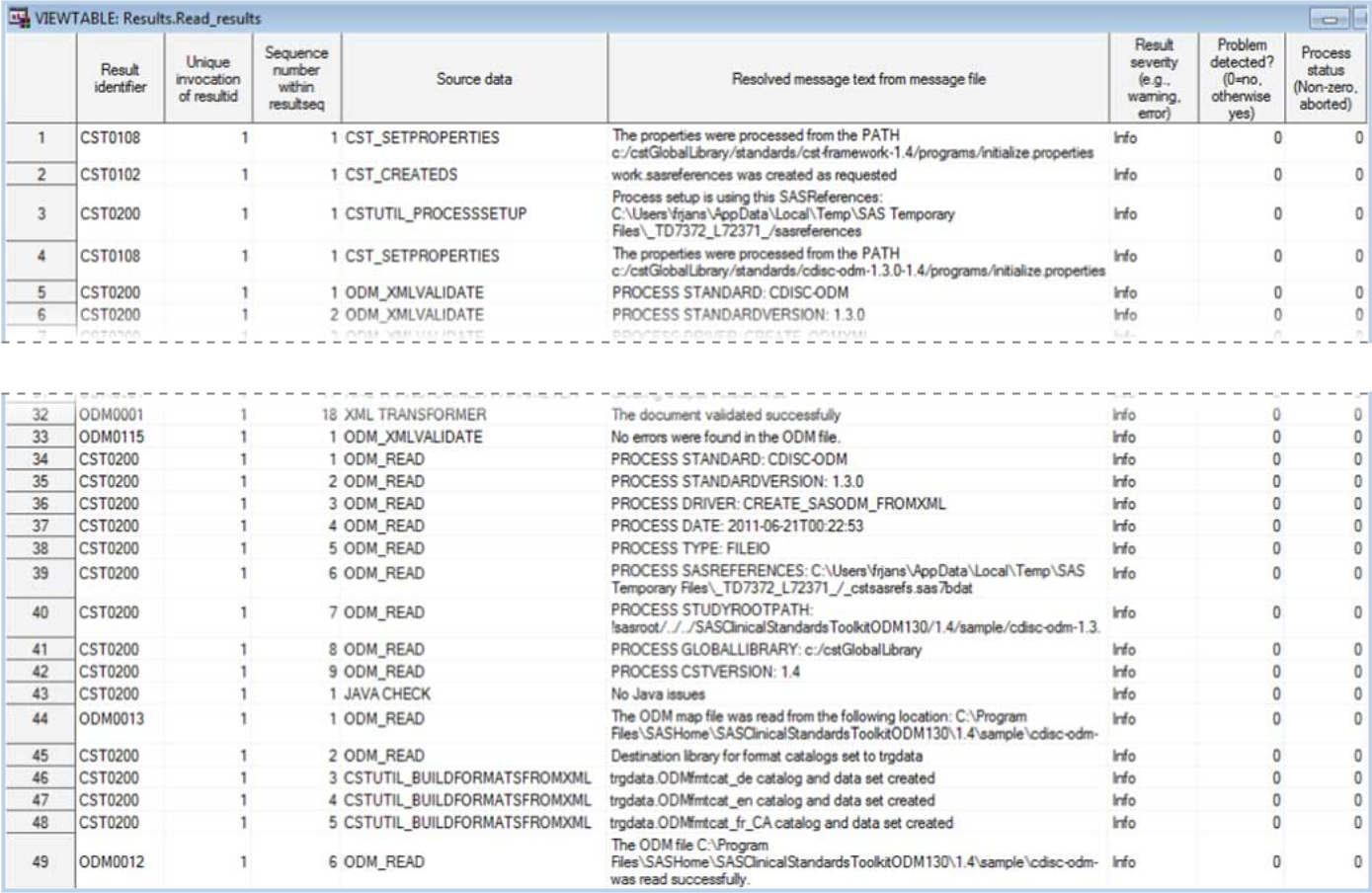
The odm_read macro creates
the source_tables and source_columns data sets in the Srcmeta library.
These data sets contain the table and column metadata for each of
the SAS data sets that are derived from the ODM XML file.
The Srcdata library
contains the SAS data sets that represent the ODM file metadata and
content. By default, the odm_read macro creates 66 unique data sets
in the SAS Clinical Standards Toolkit. Some of these data sets might
be empty if no associated content was derived from the ODM XML file.
There is a one-to-one correspondence between the tables listed in
the Srcdata library and the tables contained in the source_tables
metadata file in the Srcmeta library.
Reading CDISC CRT-DDS define.xml Files: crtdds_read Macro
The process for reading
CDISC CRT-DDS define.xml files is similar to reading CDISC ODM XML
files. The SAS Clinical Standards Toolkit supports reading a define.xml
file and translating the file metadata into a SAS representation of
the CDISC CRT-DDS model. To read the define.xml file, a specialized
macro named crtdds_read is available in the CRT-DDS 1.0 standards
macro folder, located in
<global
standards library directory>/standards/cdisc-crtdds-1.0-1.4/macros. This macro is referenced from the create_sascrtdds_fromxml.sas
driver program. There are no input parameters in the call to the crtdds_read
macro. File references and other metadata that are required by the
macro are set as global macro variables. Currently, their values are
set through the framework initialization properties and the CDISC
CRT-DDS 1.0 initialization properties processes. Throughout processing
of the crtdds_read macro, the Results data set contains all framework
and CRT-DDS 1.0 specific messages generated during run time.
Based on file references
defined in the SASReferences data set, the crtdds_read macro accesses
the define.xml file.
<ODM xmlns:xlink="http://www.w3.org/1999/xlink"
xmlns:def="http://www.cdisc.org/ns/def/v1.0"
xmlns="http://www.cdisc.org/ns/odm/v1.2" FileOID="1"
CreationDateTime="2011-07-13T17:15:43-04:00"
AsOfDateTime="2011-07-13T17:12:42"
Description="define1" FileType="Snapshot" Id="define1"
ODMVersion="1.0">
<Study OID="1">
<GlobalVariables>
<StudyName>study1</StudyName>
<StudyDescription>first study</StudyDescription>
<ProtocolName>Protocol abc</ProtocolName>
</GlobalVariables>
<MetaDataVersion OID="1" Name="CDISC-SDTM 3.1.2"
Description="CDISC-SDTM 3.1.2"
def:DefineVersion="1.0.0"
def:StandardName="CDISC SDTM"
def:StandardVersion="3.1.2">
<ItemGroupDef
OID="AE1" Name="AE" Repeating="Yes"
IsReferenceData="No"
SASDatasetName="AE" Domain="AE"
Purpose="Tabulation" def:Label="Adverse Events"
def:Class="Events"
def:Structure="One record per adverse event per subject"
def:DomainKeys="STUDYID USUBJID AEDECOD AESTDTC"
def:ArchiveLocationID="AE1">
<ItemRef ItemOID="COL1" Mandatory="Yes"
OrderNumber="1" KeySequence="1" Role="Identifier"/>
<ItemRef ItemOID="COL2" Mandatory="Yes"
OrderNumber="2" Role="Identifier"/>
<ItemRef ItemOID="COL3" Mandatory="Yes"
OrderNumber="3" KeySequence="2" Role="Identifier"/>
<ItemRef ItemOID="COL4" Mandatory="Yes"
OrderNumber="4" Role="Identifier"/>
<ItemRef ItemOID="COL5" Mandatory="No"
OrderNumber="5" Role="Identifier"/>
<ItemRef ItemOID="COL6" Mandatory="No"
OrderNumber="6" Role="Identifier"/>
<ItemRef ItemOID="COL7" Mandatory="No"
OrderNumber="7" Role="Identifier"/>
After the crtdds_read
macro confirms that the define.xml file exists, a call is made to
the SAS DATA step component JavaObj. The JavaObj processing converts
the define.xml file into the cubeXML file through transformations
using XSL files and processes. The cubeXML file is created in the
Work library. The name of the cubeXML file is _cubnnnn.xml , where nnnn is a randomly generated number. The cubeXML file is accessed using
the SAS XML LIBNAME engine and XMLMAP processing. A default XMLMAP
file is stored in the sample CRT-DDS 1.0 study folder hierarchy under /referencexml as define.map. The
define.map file must exist to process the cubeXML file. If it does
not exist, then the crtdds_read attempts to create one using the CRT-DDS
reference metadata.
<?xml version="1.0" encoding="windows-1252"?>
<SXLEMAP version="1.2">
<TABLE name="AnnotatedCRFs">
<TABLE-PATH syntax="XPath">/LIBRARY/AnnotatedCRFs</TABLE-PATH>
<TABLE-DESCRIPTION>Annotated CRF metadata</TABLE-DESCRIPTION>
<COLUMN name="DocumentRef">
<PATH syntax="Xpath">/LIBRARY/AnnotatedCRFs/DocumentRef</PATH>
<TYPE>character</TYPE>
<DATATYPE>character</DATATYPE>
<DESCRIPTION>The referenced Annotated CRF document</DESCRIPTION>
<LENGTH>2000</LENGTH>
</COLUMN>
<COLUMN name="leafID">
<PATH syntax="Xpath">/LIBRARY/AnnotatedCRFs/leafID</PATH>
<TYPE>character</TYPE>
<DATATYPE>character</DATATYPE>
<DESCRIPTION>The unique ID of the referenced Annotated CRF</DESCRIPTION>
<LENGTH>128</LENGTH>
</COLUMN>
<COLUMN name="FK_MetaDataVersion">
<PATH syntax="Xpath">/LIBRARY/AnnotatedCRFs/FK_MetaDataVersion</PATH>
<TYPE>character</TYPE>
<DATATYPE>character</DATATYPE>
<DESCRIPTION>Foreign key: MetaDataVersion.OID</DESCRIPTION>
<LENGTH>128</LENGTH>
</COLUMN>
</TABLE*
Processing of the cubeXML
file results in the derivation of the data sets (such as ItemDefs)
currently included in the SAS representation of the CDISC CRT-DDS
model.
The final step in crtdds_read
processing is the derivation of table and column metadata that describe
the data sets in the SAS representation of the define.xml file. At
this point, the crtdds_read macro is ready to create the source_tables
and source_columns data sets. The tables in the source_tables data
sets are created and copied to the output library as defined in the
SASReferences data set.
Sample Driver Program: create_sascrtdds_fromxml.sas
Overview
The SASReferences Data Set
As a part of
each SAS Clinical Standards Toolkit process setup, a valid SASReferences
data set is required. It references the input files that are needed,
the librefs and filenames to use, and the names and locations of data
sets to be created by the process. It can be modified to point to
study-specific files. For
an explanation of the SASReferences data set, see SASReferences File.
In the SASReferences
data set, there are two input file references and four output references
that are key to successful completion of the driver program. Key Components of the SASReferences Data Set lists these
files and data sets, and they are discussed in separate sections. In the sample create_sascrtdds_fromxml.sas driver program,
these values are set for &studyRootPath and &studyOutputPath
and are specific to a SAS release.
&studyRootPath=!sasroot /../../SASClinicalStandardsToolkitCRTDDS10/&_cstVersion/sample/cdisc-crtdds-1.0&studyOutputPath=!sasroot /../../SASClinicalStandardsToolkitCRTDDS10/&_cstVersion/sample/cdisc-crtdds-1.0Process Inputs
Process Inputs The metadata
type externalxml refers to the define.xml file that is being read.
The filename reference crtxml is defined in the SASReferences data
set. This filename reference is used in the submitted SAS code when
referring to the define.xml file.
The metadata type referencexml
refers to the SAS map file that is used to generate the SAS data sets
that represent the define.xml file metadata and content. The filename
reference crtmap is defined in the SASReferences data set that is
used in the submitted SAS code when referring to the SAS map file.
If a path and filename for the map file is not specified, then a temporary
map file is created as part of the crtdds_read processing.
Process Outputs
The sourcedata type
is the library where the metadata files are created. These metadata
files are the data sets that comprise the CRT-DDS information.
The sourcemetadata type
refers to two data sets that are created from the cubeXML file, source_tables,
and source_columns. Both data sets are stored in the same library.
The source_tables data set contains metadata about each table that
is derived from the CRT¬DDS process. The source_columns data
set contains similar metadata, but it is at the column level. Both
of the data sets are written to the Srcmeta library. The sourcemetadata
also refers to a data set source_study. The source_study data set
is also created in the Srcmeta library and contains study metadata.
Process Results
When the driver program
finishes running, the read_results data set is created in the Results
library. This data set contains informational, warning, and any error
messages that were generated by the submitted driver program.
The crtdds_read macro
creates the source_tables and source_columns data sets in the Srcmeta
library. These data sets contain the table and column metadata for
the SAS representation of CRT-DDS that is derived from the define.xml
file. The Srcmeta library corresponds to the location specified in
SASReferences (&studyOutputPath/ derivedmetadata).
The Srcdata library
contains the driver-generated tables that comprise the SAS representation
of the CRT-DDS model. There is a one-to-one correspondence between
the tables listed in the Srcdata library and the tables contained
in the source_tables metadata file in the Srcmeta library. The Srcdata
library corresponds to the location specified in SASReferences (&studyOutputPath/deriveddata).
When running the driver
programs against non-sample data, you must populate the SASReferences
data set in the driver program with the proper values. For
an explanation of the SASReferences data set, see SASReferences File.
